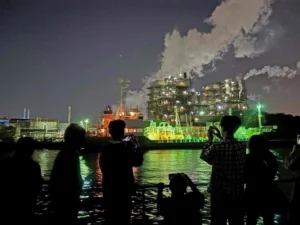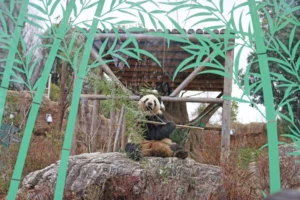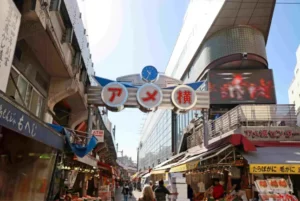
Art Overlooking Sagami Bay, return to the origins of art. Visit the timeless cultural facility, Enoura Observatory, Odawara Art Foundation
You may have wondered, "A Observatory? A place to observe the weather?" when you saw the title. Enoura Observatory is a place where, like ancient people, you can "measure" the movement of the sun while exploring the origins of art. Designed and constructed by contemporary artist Hiroshi Sugimoto, it took 20 years to complete and opened in 2017. In this article, we invite you to an art experience that transcends time, woven into the great outdoors.
Outline
Categories: #Art #Sea #Nature #Odawara #Kanagawa

You may have wondered, “A Observatory? A place to observe the weather?” when you saw the title. Enoura Observatory is a place where, like ancient people, you can “measure” the movement of the sun while exploring the origins of art. Designed and constructed by contemporary artist Hiroshi Sugimoto, it took 20 years to complete and opened in 2017.
In this article, we invite you to an art experience that transcends time, woven into the great outdoors.
Access from the hotel to Enoura Observatory
Take the JR Tōkaidō Line from Kawasaki to Nefukawa Station, then take the free shuttle bus (reservation required) for about 7 minutes.
Time required: Approximately 1 hour and 30 minutes.
Introduction: Overview of the Odawara Cultural Foundation Enoura Observatory

Enoura Observatory is by appointment only. The visit is divided into morning and afternoon sessions, each with a set capacity.
On the expansive grounds, in addition to the gallery building, there are exhibits such as the stone stage, optical glass stage, tea room, garden, and gate.The photo above is of the Meigetsu Gate. Originally built as the main gate of Meigetsuin Temple in Kamakura during the Muromachi period, it now serves as the main gate of Enoura Observatory.

This is the waiting area where visitors complete their entry procedures. In addition to the front desk, there are lockers and restrooms. The space is entirely glass-walled, allowing visitors to experience sunlight and greenery. It’s a space that heightens the anticipation for the upcoming tour.

The handouts include a map of the facility and explanations of the exhibits (with English translations). Some of the stone sculptures are very small, so it is recommended to take a leisurely stroll with a brochure in hand.

Enoura Observatory, created by clearing a mandarin orange grove, is a work of art by Mr. Hiroshi Sugimoto. The entire site is a part of his artistic vision. With the concept of “How to preserve it as a beautiful ruin 5000 years from now,” it continues to be refined even seven years after its opening. The Kōkanzan Museum, which will display Mr. Sugimoto’s collection of antique, is scheduled to open in the fall of 2027.
In this article, we will focus on spots created towards the sunrise, particularly those aligned with the 24 solar terms, such as the Spring Equinox, Autumn Equinox, Summer Solstice, and Winter Solstice.
Feel the light and the sea at the “Summer Solstice Light-Worship 100-Meter Gallery”.

Upon leaving the waiting hall, the first thing that catches your eye is the “Summer Solstice Light Reverence 100-Meter Gallery.” On the morning of the Summer Solstice, sunlight pierces through this structure for several minutes. It was created with the innovative idea of having a 100-meter-long gallery at an elevation of 100 meters above sea level.

The walls are made of unprocessed Ōya stone, quarried from a stone pit. Whether viewed from the outside or from within, it’s a sight that any stone enthusiast would find irresistible.

Inside the gallery, seven works titled “Seascapes” by Mr. Hiroshi Sugimoto are displayed. The locations where these photographs were taken span across the Caribbean Sea, the Aegean Sea, the Sea of Japan, and other parts of the world.

With the seascape of Sagami Bay right before me, I am vividly reminded that “all the oceans in the world are connected” and that “the sea has remained unchanged since ancient times.”

When viewed from below, you can see the building stretching toward the east. The area near the entrance of the tea room “Amaten” where this photo was taken is also the spot where the sunrise of the vernal and autumnal equinoxes shines through.
Light in the Darkness: “Winter Solstice Light-Worship Tunnel” and “Optical Glass Stage”

On the winter solstice, the shortest day of the year, the “Winter Solstice Light-Worship Tunnel” allows the sunrise to shine through. Like the “Summer Solstice Light-Worship 100-Meter Gallery” it is strikingly positioned protruding toward Sagami Bay.

Visitors can also walk above the “Winter Solstice Light-Worship Tunnel.” The breathtaking view and photo opportunities from there make it a popular spot for photographs. On the right side of the photo, the “Optical Glass Stage” is built in the same style as the stage at Kiyomizu-dera in Kyoto, using a wooden cantilever structure made of cypress. Optical glass is laid across it.

Visitors are allowed to proceed up to the stopping stones at the top of the “Winter Solstice Light-Worship Tunnel.” To ensure safe exploration, stopping stones are placed at various locations inside the facility.

The “Winter Solstice Light-Worship Tunnel,” which is 70 meters long, can also be walked through. Along the way, there is a “light well” that allows light to enter through a skylight.

The winter solstice sunrise, which marks both the end and the beginning of the year in the twenty-four solar terms, is received by this giant stone. Just imagining it feels mystical.
The Fossil Cave and Bamboo Grove: Traces of Time and Nature

Originally a tool shed for mikan (mandarin orange) cultivation, the “Fossil Cave” now serves a different purpose. At the entrance, there is a sign from the antique shop that Mr. Sugimoto once ran in New York.


Inside the building, you can trace the remnants of various eras, including fossils from about 500 million years ago and a bronze artifact from 4,000 years ago. It’s also unique that meteorites are on display!

The tools that were originally left in the shed are displayed just as they were. One can’t help but imagine the farming scenes from the 1950s, when mandarin orange cultivation was at its peak.

Just beside the “Fossil Cave,” at the end of the bamboo grove, there are various other exhibits.

This is the “Mathematical Model 0010,” a model of a hyperbolic function in mathematics. The sharp object floating in the green surroundings. As I gazed at it, I gradually felt my mind becoming calm and composed.
Where the Heart Finds Rest: A Visit to Kasukiyama Kasuga Shrine

At a scenic spot adjacent to the observatory, you’ll find the “Kaki-tōyama Kasuga Shrine”. The shrine was established by enshrining the spirit of the deity from Kasuga Taisha in Nara. Its structure is identical to the Kasuga-do hall of Enjō-ji in Nara, and the foundation stones date back to the Nara period.The idea behind this is rooted in the philosophy of Hiroshi Sugimoto, the artist behind Enoura Observatory, who believes that “art expresses the support of the heart.” Inside the facility, in addition to the Kaki-tōyama Kasuga Shrine, there are also other sacred objects such as the “Akazawa Hachisu Kannon” located along the approach path and the “Kataura Inari Daimyojin” in the bamboo forest. These serve as expressions of spiritual and artistic support within the space.

Right next to the lanterns of the Kasuga Shrine, there are several mikan trees (mandarin orange trees). During our visit in October, we witnessed the trees in the midst of their harvest season. This thoughtful inclusion of local agricultural practices and the preservation of the land’s memories is a unique and innovative aspect of this facility. Notably, the agricultural corporation “Plants and Humans” was established to continue cultivating citrus fruits in the area.

In addition, there are plenty of other highlights, such as the “Uchoten” tea room, accessed through a stone torii gate, and the “Old Nara-ya Gate”. With so much to see and experience, our 3-hour visit felt like it passed by in the blink of an eye.

What was surprising was the variety of stones displayed inside the museum. From historically significant foundation stones to those of unknown origin, the collection was diverse. Just like the sun and the sea, stones have existed since ancient times and have been indispensable to human life. It made me realize that, in their own way, stones are also a form of art.

Finally, if you’re heading to the “Enoura Observatory” by train or shuttle bus, make sure to enjoy a moment at the retro unmanned JR Nebukawa Station. Situated close to the sea, the station building offers a sense of openness. The time spent waiting for the train will surely become a pleasant memory.
Odawara Cultural Foundation Enoura Observatory
Address: 362-1 Enoura, Odawara City, Kanagawa
Phone: 0465-42-9170 (General inquiries)
Admission: Pre-purchase online: 3,300 yen
On-the-day tickets: 3,850 yen
- On-the-day tickets are sold only if there are available spots. Reservations can be made by phone from 9:00 AM on the day of your visit.
Viewing times: By reservation, with timed entry
Morning session: 10:00 AM – 1:00 PM
Afternoon session: 1:30 PM – 4:30 PM
For details on shuttle bus reservations, please check the website.
Closed: Tuesdays, Wednesdays, New Year’s holidays, and occasional closures
Website: https://www.odawara-af.com/ja/




